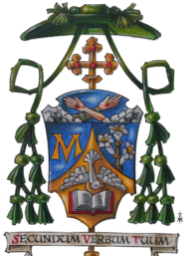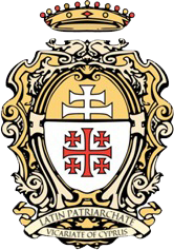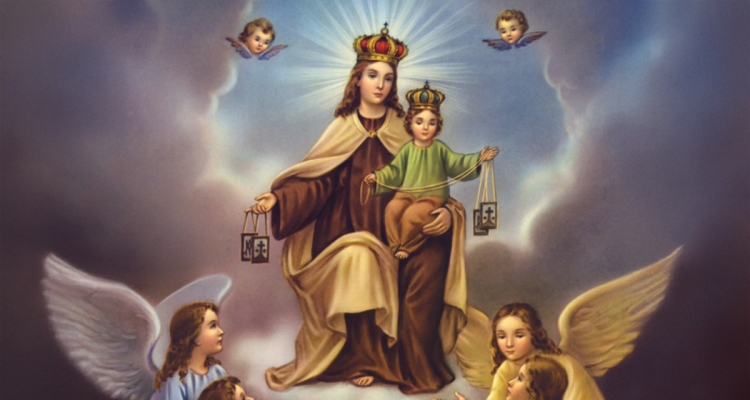Mount Carmel has been a place of prayer and closeness to God since the time of the prophet Elijah in the 10th century before Christ (cf. 1 Kings 18:41ff). It was also the site where Elijah’s prayer brought an end to the drought and famine that had befallen Israel. Because of this, the Carmelites consider Elijah one of their spiritual fathers.
The spiritual tradition continued with Christian hermits living on the mountain in persistent prayer. In the 12th century, the Order of the Brothers of the Blessed Virgin Mary of Mount Carmel was officially founded.
In the 13th century, during a time of persecution, the Blessed Virgin Mary appeared to St. Simon Stock, a Carmelite Prior, on July 16, 1251, giving him the Brown Scapular. She promised: “This is a privilege for you and the order: whoever dies wearing the Scapular will be saved.”
The wearing of a miniature version of the Carmelite Scapular—known simply as the Brown Scapular—has come to signify spiritual union with the Carmelites. It represents accepting the Blessed Mother’s love, embracing Carmelite spirituality, and trusting in her maternal protection in life and at death.
Along with being the patroness of the Carmelite Order, Our Lady of Mount Carmel is also the patron saint of Chile, Bolivia, protection from danger, and deliverance from Purgatory.
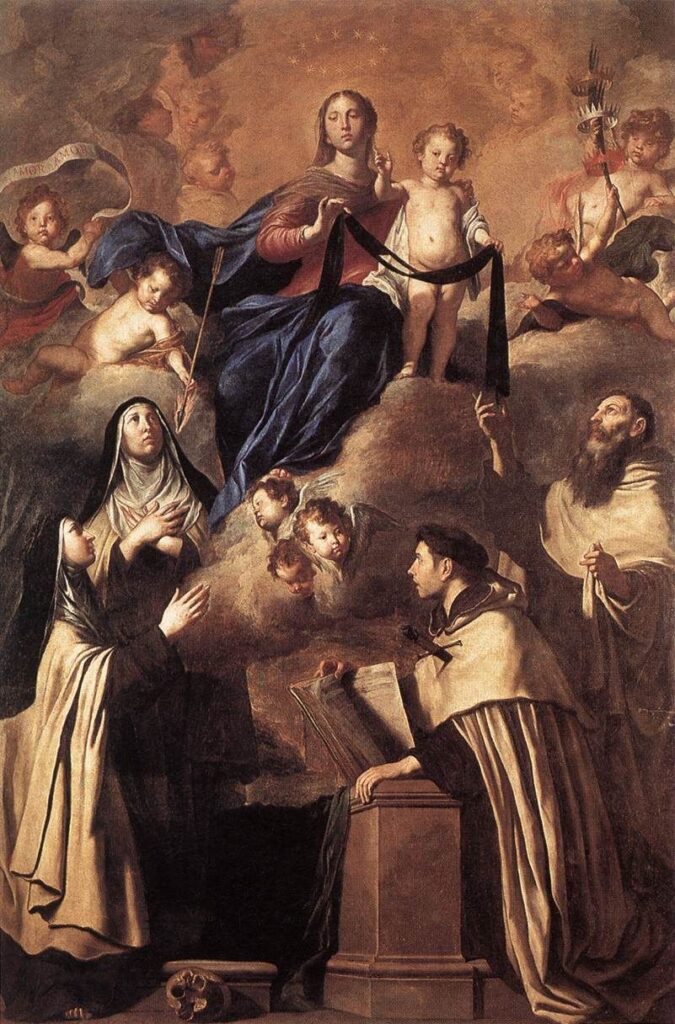
What happened on Mount Carmel with Elijah?
Mount Carmel was once a high place of worship dedicated to the Canaanite god Baal. In 1 Kings 18, Elijah challenged 450 prophets of Baal in a contest to determine the true God. The prophets of Baal failed to produce fire, but when Elijah prayed, fire fell from heaven:
“Then the fire of the LORD fell, and consumed the burnt offering… and when all the people saw it, they fell on their faces and said, ‘The LORD, he is God; the LORD, he is God.'” (1 Kings 18:38–39)
It was on Mt. Carmel, as well, that the prayer of Elijah secured the end of the drought and famine that had befallen Israel. Thus, the Carmelites consider Elijah to be one of their spiritual fathers.
Where and what is Carmel?
As a physical place, Mt. Carmel overlooks the Mediterranean sea and the city and harbor of what is today known as the City of Haifa. It sits at the head of the Valley of Jezreel, also known as the Valley of Megiddo. The Arabs know Carmel as the Mountain of St. Elijah, yet In addition to 1 Kings 18, Carmel is mentioned over twenty times in Sacred Scripture, notably in Canticles 7:5.
As a spiritual place, Carmel’s reputation certainly derives from its connection to Elijah, but its mention in the Canticle of Canticles (also known as Song of Songs or Song of Solomon) has produced the most Christian commentary. In this poem about love, the head of the Bride is compared to a Carmel – “Your head rises upon you like Carmel” – Many Christian authors, therefore, have seen the Song of Songs as an allegory of the life of union with God. Thus, in the Doctors of Spiritual Theology, such as St. John of the Cross, Carmel becomes a metaphor for seeking God (cf. Ascent of Mt. Carmel; Spiritual Canticle). For Carmelite nuns, it is the name used for their houses dedicated to contemplation.
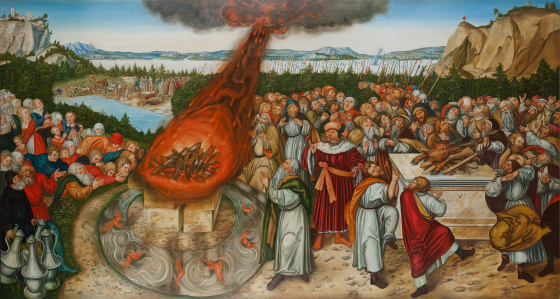
What does the name Carmel mean?
This is a Hebrew word that means “garden of God.” The Garden of God is where we can walk with the Lord, as Adam and Eve did before they were banished (Genesis 3:8)
What is the Brown Scapular?
The Scapular of Our Lady of Mt. Carmel, or Brown Scapular, consists of two pieces of brown wool on a cord. The Blessed Mother gave this sacramental to St. Simon Stock in 1251 with the promise that “Whoever dies invested with this Scapular shall be preserved from the eternal flames. It is a sign of salvation, a sure safeguard in danger, a pledge of peace, and of my special protection until the end of the ages.”
According to the Holy See’s Directory on Popular Piety, The history of Marian piety also includes “devotion” to various Scapulars, the most common of which is devotion to the Scapular of Our Lady of Mount Carmel. Its use is truly universal and, undoubtedly, it is one of those pious practices which the Council described as “recommended by the Magisterium throughout the centuries” (Second Vatican Council, Lumen Gentium, Chapter VIII).
The Scapular of Mount Carmel is a reduced form of the religious habit of the Order of the Friars of the Blessed Virgin of Mount Carmel. Its use is very diffuse and often independent of the life and spirituality of the Carmelite family.
As a small version of the Scapular of the Carmelite Order, those who wear it practicing virtue associate themselves with the Carmelite Order, both in their devotion to the Blessed Virgin Mary and their expectation of her protection.
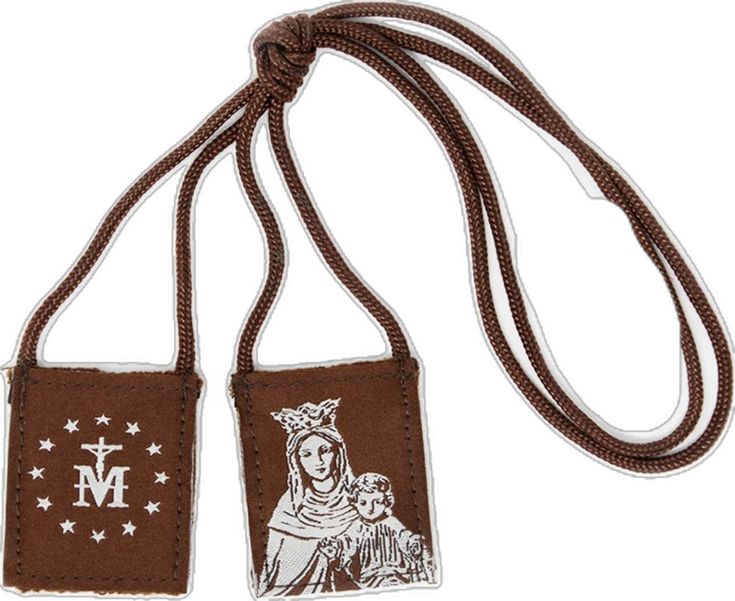
What is the spiritual meaning of Scapulars?
The “clothing” of God’s disciple is a common theme found in Sacred Scripture. Joseph’s “coat of many colors” (Genesis 37:3) is one example of the importance of clothing in the Bible. Proverbs 31, describes a good wife “clothed with strength and dignity.” Also, Isaiah 61:10 says: “I will rejoice heartily in the LORD, my being exults in my God; For he has clothed me with garments of salvation, and wrapped me in a robe of justice, Like a bridegroom adorned with a diadem, as a bride adorns herself with her jewels”.
However, the garment attains its highest spiritual meaning in the new covenant. There the follower of Jesus is said to put on Christ Himself. In Galatians 3:27, St. Paul states, “For all of you who were baptized into Christ have clothed yourselves with Christ“. In this way, garments can become a continual reminder of our call to steadfastly cling to Christ throughout the day.
The Scapular, as a special garment of consecrated religion, is known from the time of St. Benedict (6th century). His monks were to wear one over their habit while working. From this practical purpose, the Scapular came to be called “the yoke of Christ,” and acquired spiritual meaning as a sign of devotion and piety. Among the laity who associate with particular orders, or practice a particular spirituality, the smaller versions of such Scapulars are intended as similar signs and reminders.
What is a third order Carmelite?
A lay Carmelite is someone who is not a priest or nun, but he or she wants to commit, in a special way, to the Carmelite Order.
What are the Carmelites known for?
The formal name of the order is “Order of the Brothers of the Blessed Virgin Mary of Mount Carmel.” This order looks to the Old Testament prophets Elijah and Elisha as their spiritual fathers.
There have been many Carmelite saints, among whom are Doctors of the Church, including John of the Cross, Teresa of Avila, Thérèse of Lisieux, Elizabeth of the Trinity, Teresa of the Andes, and Edith Stein.
The last time that Mary appeared at Fátima, she was dressed as Our Lady of Mount Carmel. Lúcia, one of the shepherd children, later said the Blessed Mother appeared this way “because Our Lady wants all to wear the Scapular… The reason for this is that the Scapular is our sign of consecration to the Immaculate Heart of Mary.” Lúcia later became a Carmelite nun.
Carmelites follow the Gospel and take on a deeply Marian character for an evangelical life, looking to the Blessed Mother as an ideal example of prayer, love, and contemplation.
The Blessed Virgin marvels at God’s love (Luke 1:46-55), ponders the Lord in her heart (Luke 2:19), asks us to obey Jesus (John 2:5), and looks out for the wellbeing of others – especially those who are spiritually and materially impoverished. (Luke 1:39-56, John 2:1-11).
